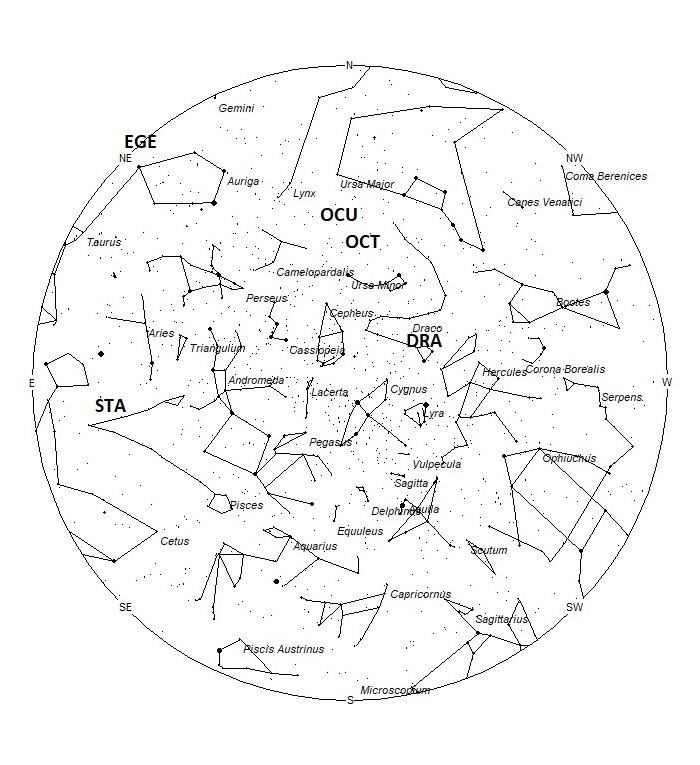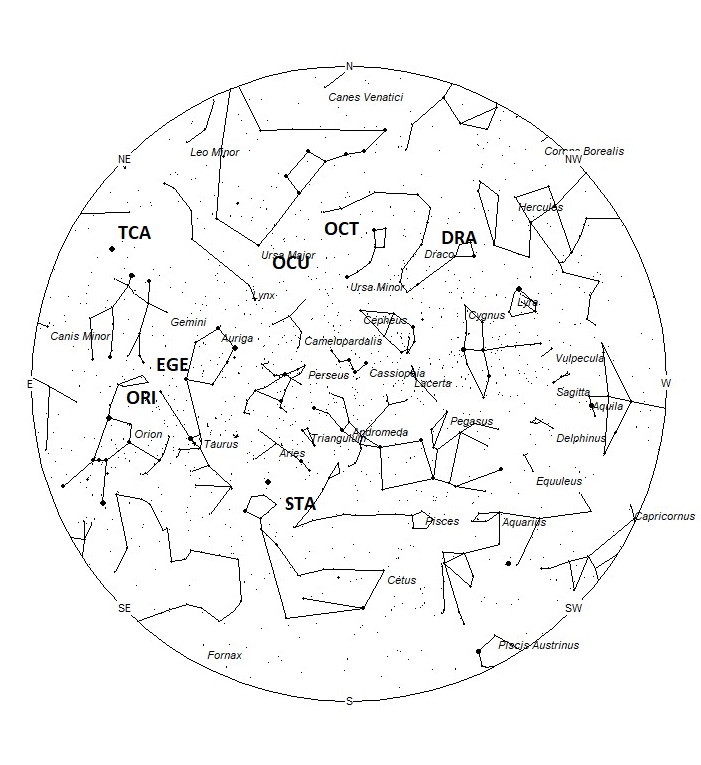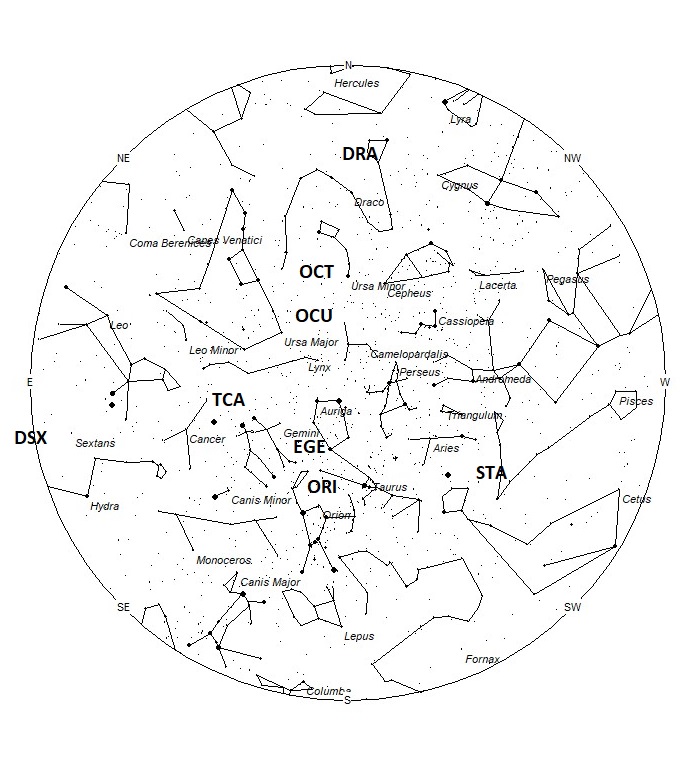During this period, the moon wanes from being half-illuminated to nearly new by Friday October 13th. Being visible in the morning sky, the moon will cause a slight reduction in meteor rates during the most active portion of the night. This reduction will disappear by mid-week as the moon wanes to a slender crescent. This weekend the waning crescent moon will rise during the early morning hours and will be bright enough to cause problems viewing meteor activity. Useful results can still be obtained by facing a direction that prevents the moon from being seen within your field of view. The estimated total hourly rates for evening observers this week should be near 4 as seen from mid-northern latitudes (45N) and 3 as seen from tropical southern locations (25S) For morning observers, the estimated total hourly rates should be near 11 as seen from mid-northern latitudes (45N) and 9 as seen from tropical southern locations (25S). The actual rates seen will also depend on factors such as personal light and motion perception, local weather conditions, alertness, and experience in watching meteor activity. Morning rates are reduced this week due to interfering moonlight. Note that the hourly rates listed below are estimates as viewed from dark sky sites away from urban light sources. Observers viewing from urban areas will see less activity as only the brighter meteors will be visible from such locations.
The radiant (the area of the sky where meteors appear to shoot from) positions and rates listed below are exact for Saturday night/Sunday morning October 7/8. These positions do not change greatly day to day so the listed coordinates may be used during this entire period. Most star atlases (available at science stores and planetariums) will provide maps with grid lines of the celestial coordinates so that you may find out exactly where these positions are located in the sky. I have also included charts of the sky that display the radiant positions for evening, midnight, and morning. The center of each chart is the sky directly overhead at the appropriate hour. These charts are oriented for facing south but can be used for any direction by rotating the charts to the desired direction. A planisphere or computer planetarium program is also useful in showing the sky at any time of night on any date of the year. Activity from each radiant is best seen when it is positioned highest in the sky, either due north or south along the meridian, depending on your latitude. Radiants that rise after midnight will not reach their highest point in the sky until daylight. For these radiants, it is best to view them during the last few hours before dawn. It must be remembered that meteor activity is rarely seen at its radiant position. Rather they shoot outwards from the radiant, so it is best to center your field of view so that the radiant lies toward the edge and not the center. Viewing there will allow you to easily trace the path of each meteor back to the radiant (if it is a shower member) or in another direction if it is sporadic. Meteor activity is not seen from radiants that are located far below the horizon. The positions below are listed in a west to east manner in order of right ascension (celestial longitude). The positions listed first are located further west therefore are accessible earlier in the night while those listed further down the list rise later in the night.
These sources of meteoric activity are expected to be active this week.
.
The Draconids (DRA) are expected to be active on October 8/9 this year. The radiant lies at 17:32 (263) +56. This position lies in southeastern Draco, very close to the position occupied by the faint star known as Kuma (nu Draconis). These meteors are best seen just as soon as it becomes dark on the evening of October 8. With an entry velocity of 21 km/sec., the average Draconid meteor would be of very slow velocity. These meteors are poorly seen from the southern hemisphere due to the low radiant altitude seen from below the equator.
The Southern Taurids (STA) are active from a wide radiant centered near 02:00 (030) +09. This position lies in southeastern Pisces, 3 degrees east of the faint star known as omicron Piscium. These meteors are best seen near 02:00 local summer time (LST) when the radiant lies highest in the southern sky. Rates are expected to be near 2 per hour no matter your location. With an entry velocity of 30 km/sec., the average STA meteor would be of medium-slow velocity.
The Orionids (ORI) are active from September 26 through November 22, with maximum activity occurring on October 21st. The radiant is currently located at 05:43 (085) +15, which places it in northern Orion, 8 degrees northwest of the 1st magnitude star known as Betelgeuse (alpha Orionis). This area of the sky is best placed for observing during the last dark hour prior to dawn, when it lies highest in the southern sky. Current rates are expected to be near 1 per hour, no matter your location. With an entry velocity of 68 km/sec., the average ORI meteor would be of swift velocity.
The epsilon Geminids (EGE) are active from September 27 through November 8 with maximum activity occurring on October 19th. The radiant is currently located at 06:05 (091) +29. This area of the sky lies in southeastern Auriga, 2 degrees west of the 4th magnitude star known as kappa Aurigae. To best see these meteors face toward the northeast during the last dark hour prior to dawn. Since maximum activity is still two weeks away, rates at this time should be less than 1 per hour no matter your location. With an entry velocity of 69 km/sec., the average EGE meteor would be of swift velocity.
The tau Cancrids (TCA) are a weak shower with a long activity period of seven weeks. They are active from September 23 through November 12 with maximum activity occurring on October 21st. The radiant currently lies at 08:22 (125) +30, which places it in northern Cancer, 6 degrees northeast of the 1st magnitude star known as Pollux (beta Geminiorum). To best see these meteors face eastward during the last two hours of the morning prior to dawn. Expected hourly rates are less than 1 per hour no matter your location. With an entry velocity of 67 km/sec., the average TCA meteor would be of swift velocity.
The October Ursa Majorids (OCU) are a recent discovery by the Japanese group known as SonotaCo. These meteors are active from October 10-20 with maximum activity occurring on October 16th. The radiant is currently located at 08:24 (126) +68. This position lies in northwestern Ursa Major, 7 degrees north of the 3rd magnitude star known as omicron Ursae Majoris. See the charts for a better idea of the location of this source. This area of the sky is best placed in the sky during the last hour before dawn, when it lies highest above the horizon in a dark sky. Current rates would be most likely less than 1 per hour no matter your location. But near maximum, rates may reach 2 per hour during the late morning hours as seen from the northern hemisphere. Due to its extreme northern position, these meteors are not visible from the southern hemisphere. With an entry velocity of 57km/sec., most activity from this radiant would be of swift speed.
The Daytime Sextantids (DSX) are active from September 22-October 13, with maximum activity occurring on October 3. The current position of the radiant is 10:43 (161) -05. This position lies in eastern Sextans, 7 degrees southeast of the 4th magnitude star known as alpha Sextantis. Rates at this time should be less than 1 per hour no matter your location. With an entry velocity of 32 km/sec., the average DSX meteor would be of medium-slow velocity. No matter your location, these meteors are difficult to observe as the radiant lies roughly 30 degrees from the sun. Therefore, these meteors may only be seen during the last hour prior to dawn, shooting upward from the eastern horizon.
The last of the October Camelopardalids (OCT) are expected on Saturday October 7th. The radiant is located at 10:51 (163) +78. This position lies in a remote area of extreme northwestern Draco. See the charts for a better idea of this location. Note that this radiant is not listed on charts for the southern hemisphere as these meteors are not visible from south of the equator. From the northern hemisphere any activity from this source is best seen during the last dark hour prior to dawn when the radiant lies highest in the northern sky. Rates are expected to be less than 1 per hour. With an entry velocity of 45 km/sec., the average OCT meteor would be of medium velocity.
Sporadic meteors are those meteors that cannot be associated with any known meteor shower. All meteor showers are evolving and disperse over time to the point where they are no longer recognizable. Away from the peaks of the major annual showers, these sporadic meteors make up the bulk of the activity seen each night. As seen from the mid-northern hemisphere (45N) one would expect to see during this period approximately 8 sporadic meteors per hour during the last hour before dawn as seen from rural observing sites. Evening rates should be near 3 per hour. As seen from the tropical southern latitudes (25S), morning rates would be near 6 per hour as seen from rural observing sites and 2 per hour during the evening hours. Locations between these two extremes would see activity between these listed figures. Morning rates are slightly reduced due to moonlight.
You can keep track of the activity of these meteor showers as well as those beyond the limits of visual observing by visiting the NASA Meteor Shower Portal. You can move the sky globe to see different areas of the sky. Colored dots indicate shower meteors while white dots indicate sporadic (random) activity. The large orange disk indicates the position of the sun so little activity will be seen in that area of the sky.
The list below offers the information in tabular form of the showers that I feel are within reach of the visual observer to discern. Hourly rates are often less than 1 but noting parameters such as the duration, radiant distance and the elevation of each meteor, one can compute the probability of shower association. Most showers discovered by video means have rates less than 1 meteor per night away from maximum, so the showers listed in these articles are not as weak as they seem. Rates and positions are exact for Saturday night/Sunday morning.
| SHOWER | DATE OF MAXIMUM ACTIVITY |
CELESTIAL POSITION | ENTRY VELOCITY | CULMINATION | HOURLY RATE | CLASS |
| RA (RA in Deg.) DEC | Km/Sec | Local Summer Time | North-South | |||
| Draconids (DRA) | Oct 08 | 17:32 (263) +56 | 21 | 18:00 | <1 – <1 | III |
| Southern Taurids (STA) | Nov 7 | 02:00 (030) +09 | 30 | 02:00 | 2 – 2 | II |
| Orionids (ORI) | Oct 21 | 05:43 (085) +15 | 68 | 06:00 | 1 – 1 | I |
| epsilon Geminids (EGE) | Oct 19 | 06:05 (091) +29 | 69 | 06:00 | <1 – <1 | II |
| tau Cancrids (TCA) | Oct 21 | 08:22 (125) +30 | 67 | 08:00 | <1 – <1 | IV |
| October Ursa Majorids (OCU) | Oct 16 | 08:24 (126) +68 | 57 | 08:00 | <1 – <1 | IV |
| Daytime Sextantids (DSX) | Oct 03 | 10:43 (161) -05 | 32 | 11:00 | <1 – <1 | IV |
| October Camelopardalids (OCT) | Oct 06 | 10:51 (163) +78 | 45 | 11:00 | <1 – <1 | IV |
Class Explanation: A scale to group meteor showers by their intensity:
- Class I: the strongest annual showers with Zenith Hourly Rates normally ten or better.
- Class II: reliable minor showers with ZHR’s normally two to ten.
- Class III: showers that do not provide annual activity. These showers are rarely active yet have the potential to produce a major display on occasion.
- Class IV: weak minor showers with ZHR’s rarely exceeding two. The study of these showers is best left to experienced observers who use plotting and angular velocity estimates to determine shower association. These weak showers are also good targets for video and photographic work. Observers with less experience are urged to limit their shower associations to showers with a rating of I to III.




